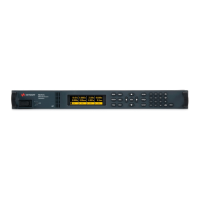You can also specify an OCP delay to prevent momentary output settings, load, and status changes
from tripping the over-current protection. In most cases these momentary conditions would not be
considered an over-current protection fault, and having an OCP condition disable the output when
they occur would be a nuisance. Specifying an OCP delay lets the OCP circuit ignore these momentary
changes during the specified delay period. Once the OCP delay time has expired and the over-current
condition persists, the output will shut down.
The delay can be programmed from 0 to 0.255 seconds. You can specify if the OCP delay timer is
started by any transition of the output into CC operation, or only at the end of a settings change in
voltage, current, or output state.
Front Panel Menu Reference SCPI Command
Select Protect\OCP
Enter an OCP delay value. Then press Select.
Under Delay Start, select "CC Transition" to start
the delay timer by ANY output transition into CC
mode. Otherwise, the delay timer will only be
started by a Settings Change in voltage, current,
or output state.
To specify a 10 millisecond delay:
CURR:PROT:DEL 0.01, (@1)
To start the delay timer by ANY output transition
into CC operation:
CURR:PROT:DEL:STAR CCTR, (@1)
To start the delay timer by a settings change in
voltage current or output:
CURR:PROT:DEL:STAR SCH, (@1)
Factors that influence how long the settings change or output load change may last include:
difference between old output value and new output value, the current limit setting, and the load
capacitance in CV operation or load inductance in CC operation. The delay required must be
determined empirically; the output programming-response time characteristics may be used as
guidelines.
Note that the time it takes the output to go into CC operation varies - depending on the magnitude of
the over-current condition compared to the current limit setting. For example, if the over-current is
only slightly greater than the current limit setting, it may take several tens of milliseconds for the
output to set the CC status bit. If the over-current is significantly greater than the current limit setting,
it may only take a few hundred microseconds or less for the output to set the CC status bit. To
determine when the output will shut down, you must add the time it takes for the CC status bit to the
over-current protection delay time. If the over-current persists beyond the sum of these two time
intervals, the output will shut down.
Models N679xA have an additional fixed over-current protection that is always enabled.
This protection will turn the output off whenever the input current exceeds 105% of the high ranges
and approximately 110% of the low current ranges.
Set the Over-Power Protection
For models N679xA only, the over-power protection will turn the output off if the input
power exceeds 110% of the module's power rating. You can program an over-power protection delay
to prevent the over-power protection function from being triggered during the delay time. This
4 Operating the Power System
156 Keysight N6700C Operating and Service Guide

